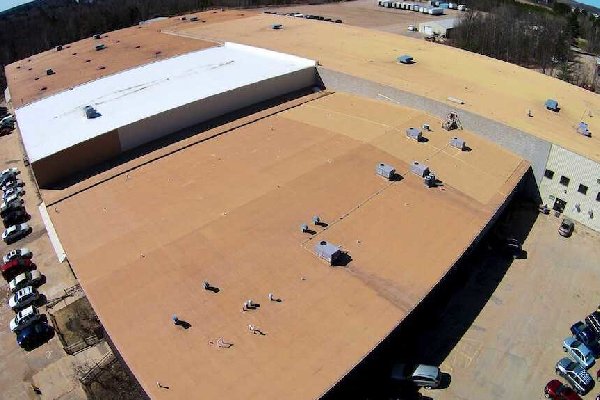Top 6 Most Common Commercial Roofing Types

What’s in a roof?
Put simply, everything that you need to keep your business operations and employees safe and dry.
On average, nearly 35 inches of precipitation falls every year in Wisconsin. You don’t want any of that water falling on your business operations. Water doesn’t mix well with inventory, electronics, and the like.
There are many commercial roof types you can choose from. Choosing the right type is essential for protecting your business’ assets. So how do you know which one to choose?
Read on to learn about your options and which type is the best!
1. Metal Roofing
Metal roofing for businesses is quite common. It has a very long lifespan of 40-60 years when properly maintained and is recyclable, making it a sustainable option.
Metal roofing won’t catch on fire and, when done well, looks very attractive. Depending on the look you want to achieve, however, it can get quite expensive.
Metal is a durable option with one very big weakness — corrosion. Without the proper protective surface layers, metal easily falls prey to environmental hazards. Sunlight, water, and pollution can all wreak havoc on a metal roof. However, if the roof is installed correctly, it’s a good option, albeit a spendy one.
2. Green Roofing
If sustainability is high on your list, green roofing is a great option. This system involves a tough, waterproof membrane covered by living green plants. It can be expensive to install but has a long life expectancy of 30-50 years.
It’s a great way to handle water drainage which is a key problem with flat roofs. Plus, you can feel confident in the fact that your business is doing its part to keep the air clean and breathable. You can even turn it into a ‘green space‘ where employees can go to relax on their breaks.
The big drawback to green roofing is maintenance. This type of commercial roofing requires constant monitoring and maintenance which can be cumbersome (and expensive) for your business.
3. Built-Up Roofing Membrane
Built-up roofing membranes are made up of a tar-and-gravel mix. The roofing is added in layers, meaning you can better control the cost of the project. Fewer layers make it less expensive, but more layers improve the durability of the roof.
It has a very short lifespan of only about 20 years and leaks are common as it begins to age. Repairs are simple — if you can find the source of the leak.
However, it’s biggest advantage is the cheaper upfront cost. Only choose this type of roof if you are on a very tight budget and plan to have to redo the roof again in a few years.
4. Modified Bitumen Roofing
Modified bitumen roofing has been covering businesses since 1975. This asphalt-type flat roofing has different modifiers like fiberglass and polyester added to it to strengthen the roof.
If you will have people walking around on your roof a lot, a modified bitumen roof can be a good idea. Installation is also cost-effective and the material is very waterproof.
Like a built-up roofing membrane, don’t expect a long lifespan. Depending on how you maintain it, you may only get 10-20 years out of the roof.
It also isn’t the most attractive option. The vast majority of modified bitumen roofing only comes in black. Not only is it less than pretty, but also the black color means it will absorb heat from the sun and run up your cooling costs.
5. Thermoset EPDM Membrane
A popular type of membrane roofing is the Ethylene Propylene Diene Terpolymer. That mouthful is also known simply as EPDM. This type of roofing will last a long time and is easy to maintain.
The membrane is made of a single-ply type of rubber. The material is flexible, which allows for movement as temperature fluctuations cause the structure to expand and contract. The system is resistant to sunlight, pollution, and even chemicals like some acids and solvents.
This is also definitely not a pretty option. However, you do get two color choices — white or black.
6. PVC Roofing Membrane
Want a roof that will last a long time, won’t get damaged easily, and will impede the spread of flames in a fire? In that case, PVC roofing is an excellent option.
While other types of roofing membranes won’t necessarily burst into flame, they will melt and the damage can spread easily. A PVC membrane actually impedes the flames and works to self-extinguish the fire.
On top of that, PVC roofing is lightweight and highly weather-resistant, including resisting UV rays from the sun. It is also very reflective, which helps a lot when it comes to savings on your energy bill. The membrane is also resistant to bacteria growth, high temperatures, and most chemicals.
The quality of PVC roofing systems is outstanding. In fact, here at Nasi Roofing we are so impressed by it that we only install Duro-Last roofing systems — the best manufacturer of this type of roofing. We want to provide our customers with the best roof possible and this is the way to do it in our professional opinion.
Commercial Roof Types: Choosing the Best
There are many commercial roof types available. Your specific needs will dictate the choice that is right for your business.
However, for most businesses, a Duro-Last PVC roofing system is the right choice. That’s why we’ve chosen to become an authorized contractor and specialize in this type of roofing.
Ready to learn more? Contact us today! We’re happy to answer all your questions and help you choose the right roofing for your Wisconsin business.
